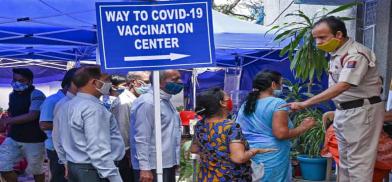Covid vaccination in India: Authorities need to reach out to vulnerable population in remote areas
The government needs to decentralize health administration by empowering local health infrastructure for a fair distribution of vaccine doses so that they penetrate hard-to-reach groups, write Abhinav Mehrotra and Dr. Biswanath Gupta for South Asia Monitor

As the second wave of the novel coronavirus disease (Covid 19) continues to take its toll in India, the impact on rural areas is devastating which was not the case during the first wave. Experts have highlighted multiple factors, but we think the vaccine hesitancy on part of both the people and the health workers during the initial phases was one of the primary reasons for the devastation.
Though hospitals are now less overwhelmed with people, initially in April, the patients were not been able to find hospital beds, get supplies of oxygen cylinders and adequate medical care. Even the health workers seemed drained out seeing the high number of deaths daily. But a more important hurdle that needs to be encountered now is ensuring equitable distribution of vaccines to not only urban centers, but also the rural areas where more than 65 percent of the country's 1.3 billion population resides.
India's rural health structure
In practice, the rural Indian health structure consists of sub-centers at the peripheral level, followed by the primary health centers (PHCs) and the community health centers (CHCs). These centers cater to different kinds of needs. A sub-center is responsible for providing basic drugs for minor ailments; the PHCs provide curative and preventive healthcare; and the CHCs are armed with four medical specialists - the surgeon, the general physician, gynecologist, and pediatrician.
One instance of the successful running of all the three structures is the execution of an effective comprehensive immunization program for the BCG vaccine (Bacillus Calmette–Guérinis, a vaccine primarily used against tuberculosis) throughout India.
Given the severity of the second wave of Covid 19 in India, there is a need to combine all the three-tier structure components as a whole to fight the ongoing pandemic. In this sense, inspiration can be drawn from the polio vaccination program that had successfully eradicated the disease in India. Most importantly, the benefits of the vaccination program were experienced by the people residing in remote areas of the country.
The success of the polio eradication program was based on three principles - bundling of health services, local stakeholder engagement and putting in place the accountability mechanisms. In layman's language, this meant offering services like check-ups; free medicines, etc; at the same time engaging the community leaders to spread awareness such as the advertisement of polio vaccine "do boond zindagi ki' (two drops of life); and lastly ensuring availability of authentic data regarding the inoculation program.
Coming back to the Covid 19 pandemic, Indian Prime Minister Narendra Modi recently shared his concerns about the spread of the virus into the rural parts of India. Some disturbing visuals such as the dead bodies in the Ganga and bodies in shallow graves on its banks, as well as of other rivers, are evidence of the spread of the virus in the rural areas.
The abysmal state of infrastructure in the rural areas is reflected through the examples of two districts in Punjab i.e. Sangrur and Tarn Taran. For the 1.66 million population in Sangrur, there were only 296 Covid beds, whereas, for Tarn Taran, only 300 Covid beds are available for a population of 1.12 million. This has resulted in high fatality rates in these two districts alone.
Role of center, states
What this signifies is that the need of the hour is for governments at both the center and the states to accept their mistakes and focus on preventing the adverse effects of the ongoing pandemic in the rural areas. This can be done by taking steps like allocating vaccines among states based on the proportion of vulnerable populations; spreading information in the regional languages of these areas so that everyone can understand; and decentralizing the local management and putting the panchayats i.e. the rural self-governments, at the forefront. One such example is the state of Kerala that has set up panchayat-level war rooms, call centers and domiciliary care centers.
In contrast, the government has relied on imposing lockdowns which have a devastating impact on the poor people in the rural areas who are mostly daily wagers. As for the ongoing lockdown, the unlock process would be based on three pillars - i.e. the positivity rate has to be less than 5 percent over one week; over 70 percent of the vulnerable population should be vaccinated; and community support should be there for adopting Covid appropriate behavior. All these factors seem far-fetched especially when it comes to rural areas.
A three-pronged approach
To achieve an effective solution to the pandemic, a three-pronged approach is required that includes treatment of the affected population; tracking and slowing the spread of the virus, and protecting the rest of the population who are still not exposed to the virus, and therefore, more vulnerable.
The key is the third step for the rural areas due to the huge number of people that are covered through these regions who tend to be suspicious over the vaccination programs as they are denied other essential services like sanitation, livelihood; or education.
The government needs to decentralize the health administration by empowering the local health infrastructure for a fair distribution of vaccine doses so that they penetrate the hard-to-reach groups, i.e. those population sub-groups that are difficult to reach due to their physical and geographical location or their social and economic situation.
(Abhinav Mehrotra is Lecturer at O.P. Jindal Global University, Sonipat, India. He can be contacted at amehrotra@jgu.edu.in. Dr. Biswanath Gupta is Assistant Professor at the O.P. Jindal Global University. He can be contacted at bgupta@jgu.edu.in. The views expressed are personal)










Post a Comment